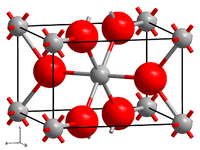Magnesium hydride
| Crystal structure | ||||||||||||||||
|---|---|---|---|---|---|---|---|---|---|---|---|---|---|---|---|---|

|
||||||||||||||||
| __ Mg 2+ __ H - | ||||||||||||||||
| General | ||||||||||||||||
| Surname | Magnesium hydride | |||||||||||||||
| Ratio formula | MgH 2 | |||||||||||||||
| Brief description |
white solid |
|||||||||||||||
| External identifiers / databases | ||||||||||||||||
|
||||||||||||||||
| properties | ||||||||||||||||
| Molar mass | 26.321 g mol −1 | |||||||||||||||
| Physical state |
firmly |
|||||||||||||||
| density |
1.45 g cm −3 |
|||||||||||||||
| Melting point |
280–300 ° C (decomposition) |
|||||||||||||||
| solubility |
|
|||||||||||||||
| safety instructions | ||||||||||||||||
|
||||||||||||||||
| As far as possible and customary, SI units are used. Unless otherwise noted, the data given apply to standard conditions . | ||||||||||||||||
Magnesium hydride is a hydride of the light metal magnesium with the formula unit MgH 2 .
synthesis
Processes have been described for the synthesis of magnesium hydride from the elements magnesium and hydrogen , which, however, require either very high pressures and temperatures or catalysts that are difficult to handle and sometimes toxic . These processes are therefore economically (and ecologically) unfavorable.
For example, the reaction can be obtained with a mixture of alkyl iodide , propargyl bromide and iodine as a catalyst.
The high pressure reaction of a magnesium halide such as magnesium iodide dissolved in ether with sodium hydride is also possible .
The hydrogenation of magnesium releases energy (heat) so that it should actually continue to run spontaneously. However, the speed of the reaction is considerably inhibited (kinetic inhibition). Catalysts can lower this inhibition threshold. Magnesium hydride itself catalyzes its own formation ( autocatalysis ), as Wilfried Knott found out. If little magnesium hydride is present, further formation is possible under medium pressure and temperature conditions.
The product made in this way is a gray powder with little magnesium impurities.
Production by heating magnesium dialkyls (e.g. magnesium diethyl , magnesium dibutyl , magnesium diphenyl ) or corresponding Grignard compounds in a high vacuum is also possible.
properties
Activated, finely divided magnesium hydride is pyrophoric , but macrocrystalline magnesium hydride does not ignite in air, but needs more than 300 degrees Celsius for this. Like most metal hydrides, magnesium hydride reacts violently with water, splitting off hydrogen.
use
One kilogram of hydride can store up to 800 liters of hydrogen gas as hydride (approximately 7% of the combined mass is then hydrogen). Although ordinary fuel such. B. gasoline has a significantly higher energy density , but compared to batteries or liquid gas storage tanks, the energy density is higher. It should be noted, however, that the effective energy density is somewhat lower, as energy in the form of heat is required to release the hydrogen. Since the hydrogen can also be released reversibly at higher temperatures, it can be used as a hydrogen storage device. A current research focus is on reducing the higher temperature required for hydrogen release in order to enable practical use.
A metal foam with interesting properties (e.g. lighter than water) can be created using hydrogen released from magnesium hydride.
Individual evidence
- ↑ a b data sheet magnesium hydride from AlfaAesar, accessed on March 14, 2010 ( PDF )(JavaScript required) .
- ↑ a b c Entry on magnesium hydride. In: Römpp Online . Georg Thieme Verlag, accessed on July 14, 2014.
- ↑ a b Data sheet Magnesium hydride from Sigma-Aldrich , accessed on April 9, 2011 ( PDF ).
- ↑ a b c Georg Brauer (ed.), With the collaboration of Marianne Baudler a . a .: Handbook of Preparative Inorganic Chemistry. 3rd, revised edition. Volume II, Ferdinand Enke, Stuttgart 1978, ISBN 3-432-87813-3 , p. 902.




